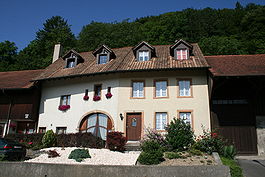Villigen
| Villigen | ||
|---|---|---|
 |
||
|
||
| Coordinates: 47°32′N 8°13′E / 47.533°N 8.217°ECoordinates: 47°32′N 8°13′E / 47.533°N 8.217°E | ||
| Country | Switzerland | |
| Canton | Aargau | |
| District | Brugg | |
| Area | ||
| • Total | 11.22 km2 (4.33 sq mi) | |
| Elevation | 367 m (1,204 ft) | |
| Population (Dec 2015) | ||
| • Total | 2,029 | |
| • Density | 180/km2 (470/sq mi) | |
| Postal code |
5234 Villigen 5233 Stilli |
|
| SFOS number | 4121 | |
| Surrounded by | Böttstein, Brugg, Hottwil, Mandach, Remigen, Rüfenach, Untersiggenthal, Würenlingen | |
| Website |
www SFSO statistics |
|
5234 Villigen
Villigen is a municipality in the district of Brugg in the canton of Aargau in Switzerland. In January 2006, Villigen incorporated the former municipality of Stilli.
The Paul Scherrer Institute is primarily located in Villigen, although part is across the Aare river in Würenlingen.
Villigen has an area, as of 2009[update], of 11.22 square kilometers (4.33 sq mi). Of this area, 3.88 square kilometers (1.50 sq mi) or 34.6% is used for agricultural purposes, while 5.5 square kilometers (2.1 sq mi) or 49.0% is forested. Of the rest of the land, 1.51 square kilometers (0.58 sq mi) or 13.5% is settled (buildings or roads), 0.31 square kilometers (0.12 sq mi) or 2.8% is either rivers or lakes.
Of the built up area, housing and buildings made up 5.7% and transportation infrastructure made up 2.7%. Power and water infrastructure as well as other special developed areas made up 4.6% of the area. 47.6% of the total land area is heavily forested and 1.4% is covered with orchards or small clusters of trees. Of the agricultural land, 18.1% is used for growing crops and 13.4% is pastures, while 3.1% is used for orchards or vine crops. All the water in the municipality is in rivers and streams.
The blazon of the municipal coat of arms is Azure a Bear's Gambe in pale couped Or and in Chief three Mullets of Five of the same one and two and Coupeaux Vert.
Villigen has a population (as of December 2015[update]) of 2,029 As of June 2009[update], 22.6% of the population are foreign nationals. Over the last 10 years (1997–2007) the population has changed at a rate of 3.6%. Most of the population (as of 2000[update]) speaks German (88.8%), with Italian being second most common ( 2.4%) and Albanian being third ( 1.7%).
...
Wikipedia




